| February 23, 2019
We have your 2019 Ducati Hypermotard 950 review, and we also got to spend time on the 950SP version.
Bologna’s bad-boy supermoto gets more power and tech in that hard-hitting street style.
Whether it’s a pet, a family member, or a motorcycle, “hyper” isn’t something you usually want. But Ducati tends to focus on extremes and, at least partly for that reason, the lightest and the fastest (not to mention the reddest) bikes on the road have often come from Bologna.
In 2008, Ducati set out to create a bike with unprecedented attitude and energy—for “hooligan riders,” as the company line says—and thus, the Hypermotard was born.
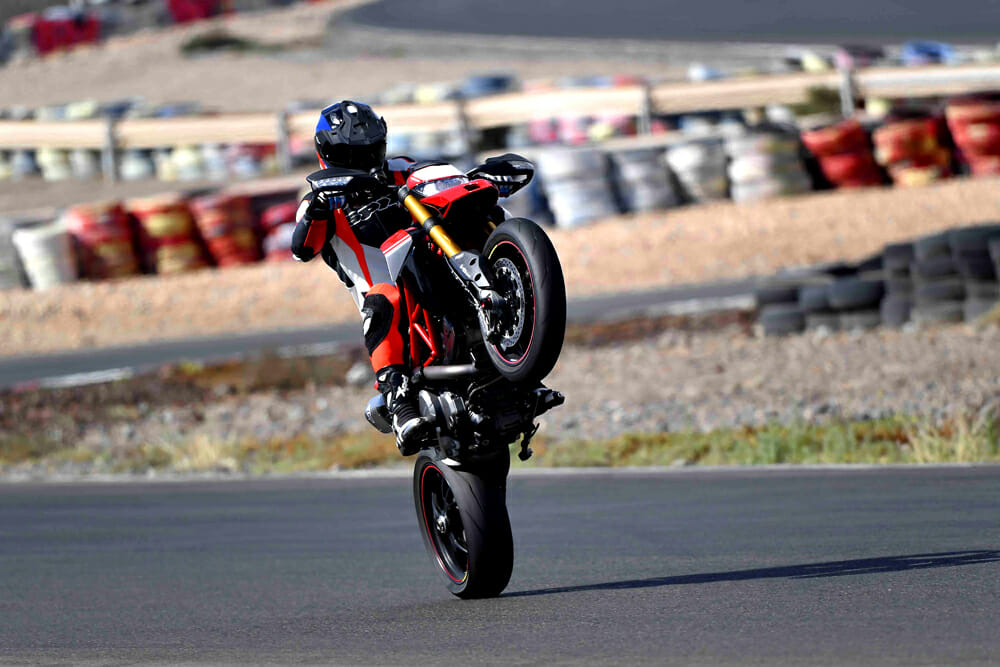 You want wheelies, do ya? The Hypermotard is the boss right here. Read the full 2019 Ducati Hypermotard 950 Review below.
You want wheelies, do ya? The Hypermotard is the boss right here. Read the full 2019 Ducati Hypermotard 950 Review below.
A Bit of Background 2019 Ducati Hypermotard
Originally, the Hyper used Ducati’s burly, air-cooled 1100cc powerplant, which was at that time a flagship of the street lineup. The evolution toward the Hypermotard 939 took the bike toward a leaner, more modern design, and also arguably a little less focused. With the introduction of the windshielded and saddlebagged Hyperstrada, Ducati aimed to show that the Hyper platform could be practical. And it was, but some argued that it was losing the purity of a hooligan bloodline. In 2019, the third generation hits the streets as the new Hypermotard 950, and incorporates many updates that seem to take it back toward its roots of aiming to be the most irreverent motorcycle on the road.
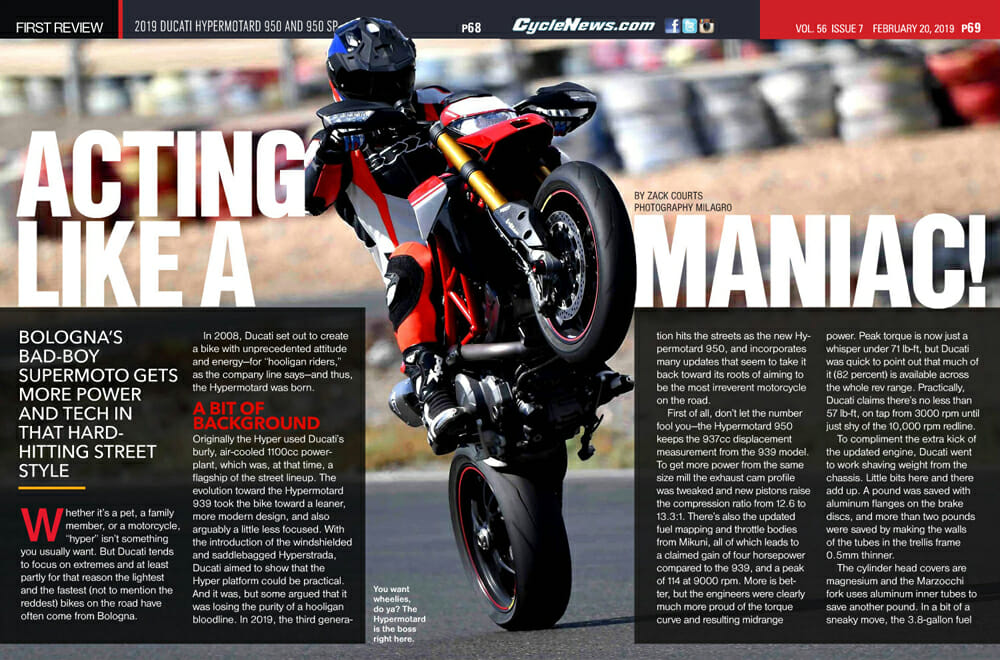
By Zack Courts | Photography by Milagro
First of all, don’t let the number fool you—the Hypermotard 950 keeps the 937cc displacement measurement from the 939 model. To get more power from the same size mill, the exhaust-cam profile was tweaked and new pistons raise the compression ratio from 12.6 to 13.3:1. There’s also the updated fuel mapping and throttle bodies from Mikuni, all of which leads to a claimed gain of four horsepower compared to the 939, and a peak of 114 at 9000 rpm. More is better, but the engineers were clearly much more proud of the torque curve and resulting midrange power. Peak torque is now just a whisper under 71 pound-feet, but Ducati was quick to point out that much of it (82 percent) is available across the whole rev range. Practically, Ducati claims there’s no less than 57 pound-feet on tap from 3000 rpm until just shy of the 10,000 rpm redline.
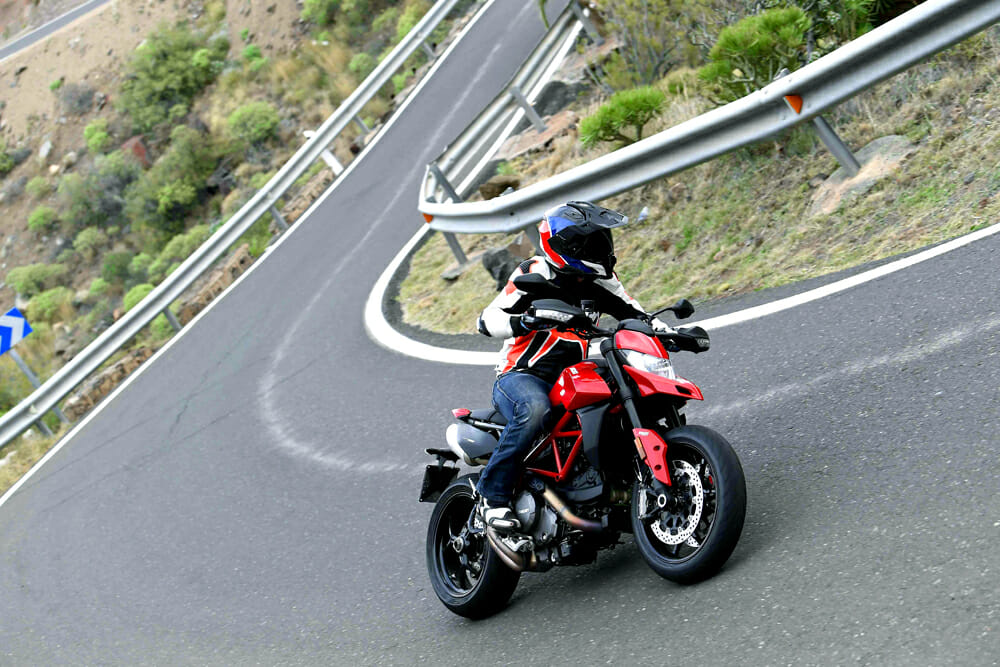 Road manners are quite polite for a bike as rowdy as this. Tall riders will love the range of movement the wide bars and high seat give.
Road manners are quite polite for a bike as rowdy as this. Tall riders will love the range of movement the wide bars and high seat give.
To complement the extra kick of the updated engine, Ducati went to work shaving weight from the chassis. Little bits here and there add up. A pound was saved with aluminum flanges on the brake discs, and more than two pounds were saved by making the walls of the tubes in the trellis frame 0.5mm thinner.
 The level of finish is superb on the Hyper. It may say 950 on the sticker, but it’s still a 939.
The level of finish is superb on the Hyper. It may say 950 on the sticker, but it’s still a 939.
The cylinder head covers are magnesium and the Marzocchi fork uses aluminum inner tubes to save another pound. In a bit of a sneaky move, the 3.8-gallon fuel tank is smaller by 0.4 gallons (a few pounds), which contributes to lessening the ready-to-ride weight. Still, all told a claimed 8.8 pounds was shed off the Hyper 950’s curb weight, compared to the outgoing 939 model, for a total of 440 pounds.
Most of us can agree that more power and less weight is a good recipe for a better bike, but from Ducati’s point of view, there was more about the machine that needed to evolve. The Hypermotard is, in the words of Product Manager Paolo Quattrino, “visually high from the ground.” In raw numbers that’s a 34.2-inch seat height on the base bike, and 35 inches on the Ӧhlins-equipped 950 SP. That’s great for the bike’s image, but less great for riders with shorter inseams. So Ducati went about trying to keep the Hyper “visually” tall but practically less so.
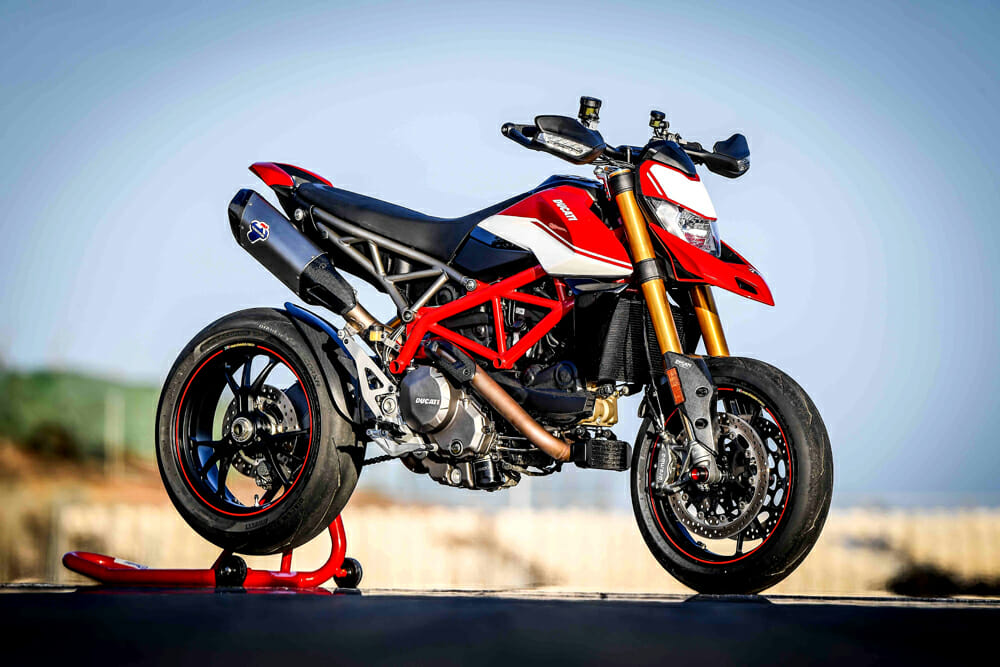 Attitude is the name of the game with the Hyper. But it’s now a little more sedate and designed to get more riders on its rather tall seat.
Attitude is the name of the game with the Hyper. But it’s now a little more sedate and designed to get more riders on its rather tall seat.
The aesthetic of the new 950 is clearly supermoto inspired—the seat is long and flat, and the whole machine angles forward. While maintaining that shape, the Ducati team aimed to make the bike more approachable by narrowing the middle of the bike and therefore reducing the practical seat height (or stand-over height). The seat-height measurements are the same as the 939 version for both the standard and SP models, but Ducati claims the stand-over height of the bike has been reduced by two inches. In other words, it should be just as easy for a rider with a 30-inch inseam to swing a leg over the Hyper 950 at it was a rider with a 31-inch inseam to climb aboard a Hyper 939.
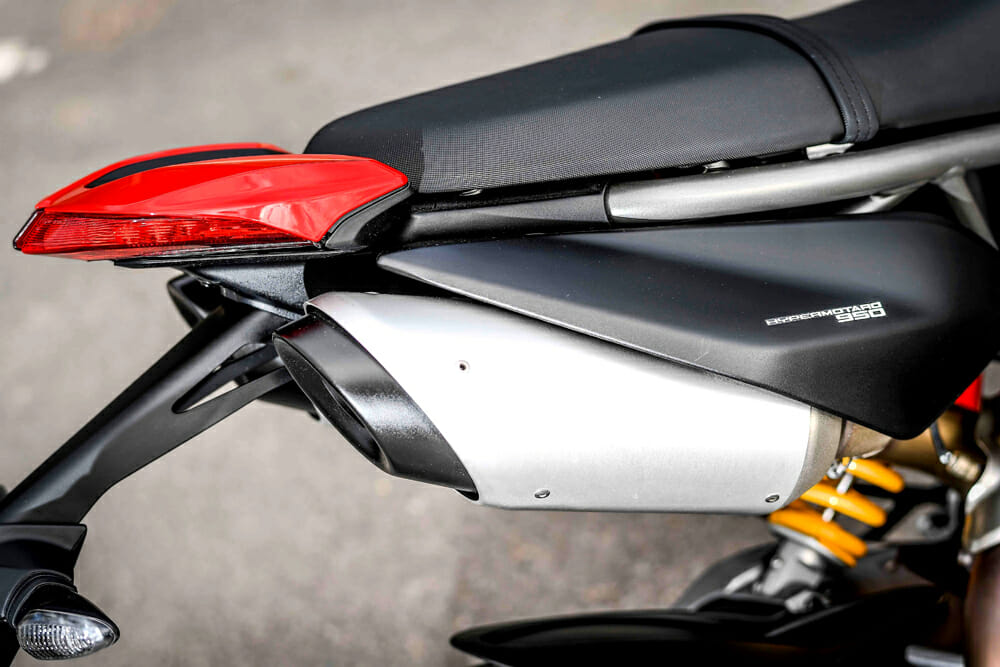 Passengers will likely have a hard time on this pew after not so long on board.
Passengers will likely have a hard time on this pew after not so long on board.
Arguably in that same vein, Ducati will offer a low-power (47 hp) version of the Hyper 950 in Europe, in the hopes of attracting less experienced riders on lower-tiered licenses. And with that the mantra of the Hyper 950 starts to take shape: More aggressive and truer to the hooligan foundation, but also a gateway for potential Ducati sport riders that don’t want a Panigale.
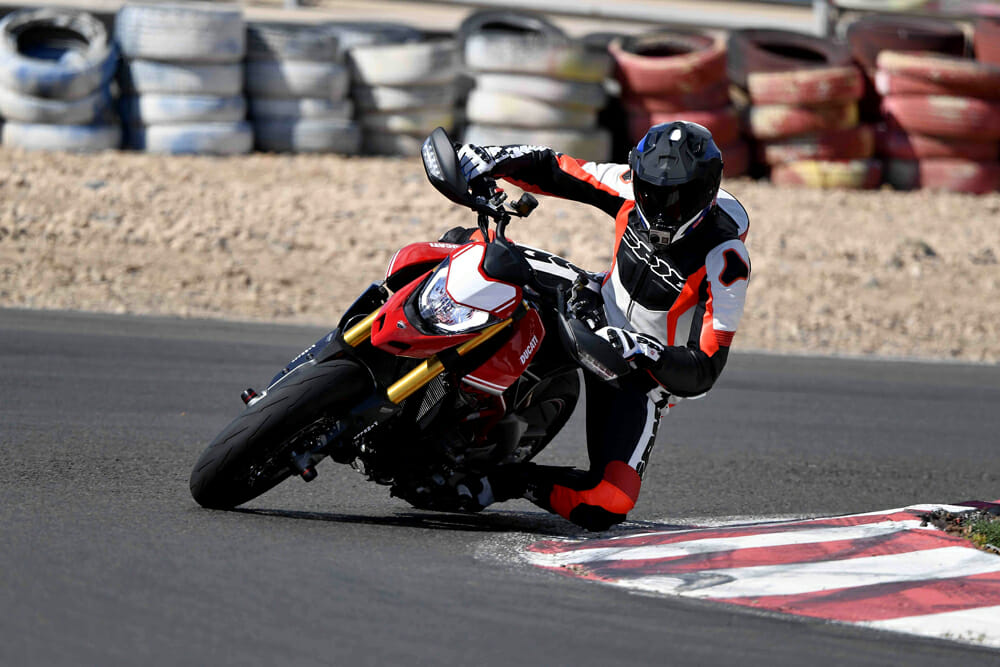 Take a Hyper to a trackday and embarrass guys on R1s. You’ll never laugh so hard.
Take a Hyper to a trackday and embarrass guys on R1s. You’ll never laugh so hard.
Test riding the 2019 Ducati Hypermotard 950 and 950 SP
Every experienced motorcyclist knows that pure numbers don’t tell the whole story, and therefore making a bike narrower, lighter, and more powerful doesn’t necessarily make it better. And so Ducati arranged a test ride around the island of Grand Canary—not-so-conveniently located about 150 miles off the coast of Morocco—to test both the standard 2019 Hypermotard 950, as well as the up-spec SP version.
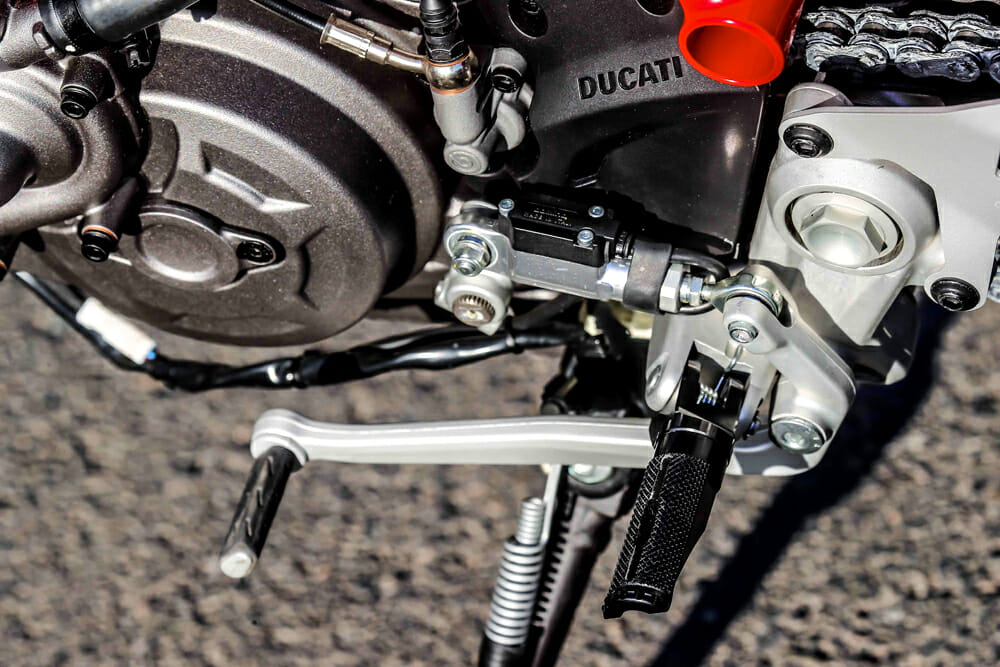 Ducati Quick Shift comes as standard on the SP but will cost you some extra dollars on the base model.
Ducati Quick Shift comes as standard on the SP but will cost you some extra dollars on the base model.
First up for our 2019 Ducati Hypermotard 950 review was ripping around the supermoto-tight Circuit Maspalomas on the $16,695 Hypermotard 950 SP, prepared for us without blinkers, license-plate holder, or mirrors, and sporting an accessory Termignoni race exhaust. Because of that, it was tricky to tell how the SP would be as a road-going, everyday machine. An educated guess is that it would be a little stiff, on account of the Ӧhlins fork and shock, which feel more suited for track use (and also extend travel an inch in the shock and 0.6 inches in the fork).
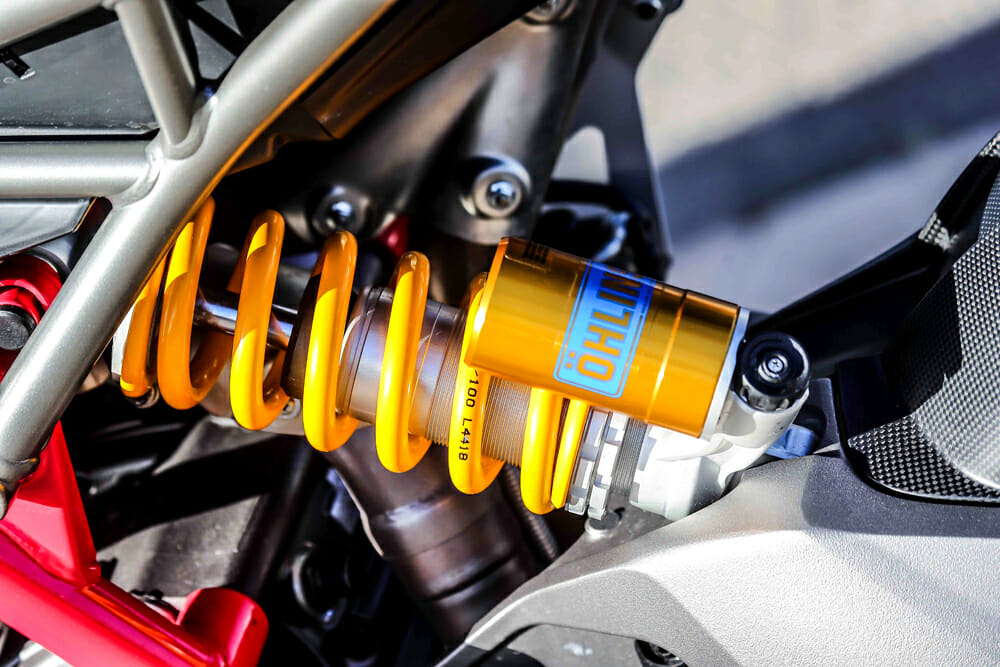 Gold Ӧhlins and Ducatis go together like peanut butter and jelly.
Gold Ӧhlins and Ducatis go together like peanut butter and jelly.
Once on board and hammering around a circuit, some aspects are crystal clear. Foremost, the brakes have endless power and perfect predictability; Ducati brakes are often excellent and the Hyper 950 is no exception. The suspension is also very much up for a scrap, feeling right at home on the track, with sublime compliance and feel. The SP is ready to get rowdy at a racetrack if that tickles your fancy.
One major complaint is not being able to shut off ABS. Ducati applied a “slide-by-brake” system on the Hyper 950—similar to the Panigale V4 in that it allows a certain amount of rear-wheel slippage entering a corner—but it’s not always fluid to use. Perhaps it’s Ducati being a step ahead for Euro 5 regulations in 2020, which will require ABS at all times. But of all the bikes to not be able to back into a corner on a whim or a track, it’s sad that a Hyper has to be one of them.
The longer suspension equals a taller seat, too. A very tall seat, actually, at 35-inches high. Herein lies a paradox of the Hypermotard, however, in that it feels unnaturally light. It’s 10 pounds heavier than a Panigale V4S, yet somehow it’s not cumbersome or even heavy coming off the kickstand. It also looks dense and small without seeming cluttered with stuff. Some of this impression surely had to do with the SP being stripped for track duty (and having forged Marchesini wheels standard), but climbing aboard the standard bike for a jaunt into the mountains it was a similar story.
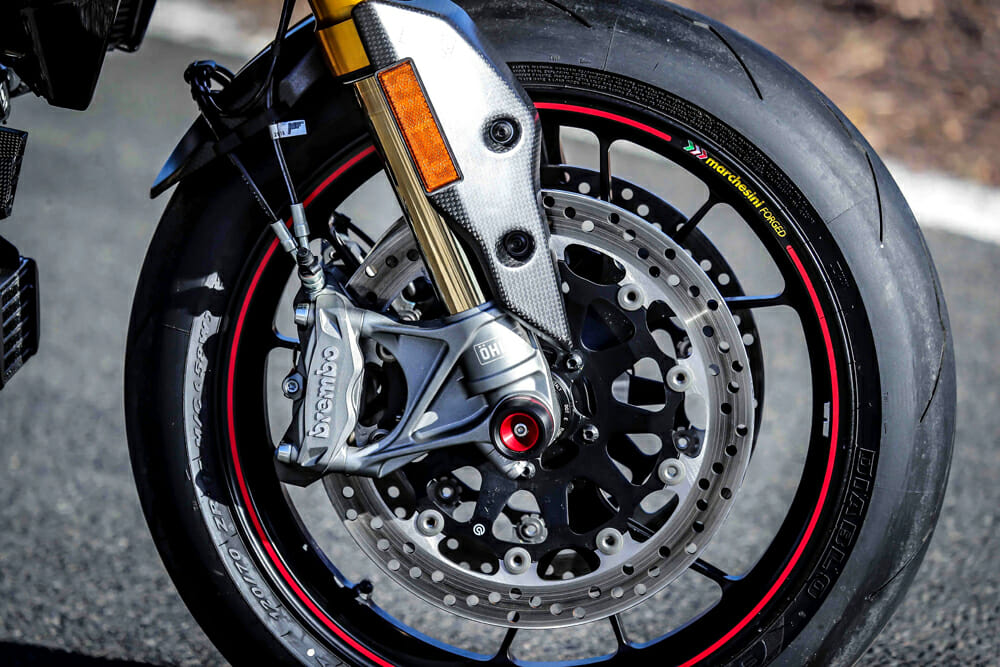 The SP comes with beautiful forged aluminum Marchesini wheels.
The SP comes with beautiful forged aluminum Marchesini wheels.
There’s a more muffled and polite grumble from the stock, twin exhaust tucked up under the 950’s tail. It still encourages a quick twist of the grip and sends a nice bark out the pipes when goaded. The seat is a little lower, at 34.2-inches, but it still makes for a tall and narrow machine. A silver lining on that topic is that there’s plenty of legroom. To open the riding position even further, the handlebar sweep is reduced by seven degrees. Who knows what seven degrees looks like, but you feel a little more settled over the fork and in a slightly more commanding riding position.
 Mission control for the Hyper’s electronics on the left bar.
Mission control for the Hyper’s electronics on the left bar.
Sorely missed on the blast up the mountain during part two of our 2019 Ducati Hypermotard 950 review was the SP’s standard up/down quickshifter. The standard bike comes ready to be equipped with the DQS (Ducati Quick Shift) system, but it’ll have to be an accessory catalog purchase (for about 300 euros, we’re told). Mirrors are tidy and unobtrusive, but leave you with a taste of “afterthought” in your mind.
The dash is a lovely, 4.3-inch TFT with a menu system that mimics the Multistrada 1260 and other Ducatis, with info displayed in mock-Panigale style—a faux-analog tachometer on the right, and other data to the left. It works predictably if you’re used to Ducati systems, and it’ll take a little getting used to if you’re not. The one major downside is that the Hyper’s tall, flat seat and general ergonomics mean the dash isn’t easily in view while riding. That’s an artifact of a supermoto-style machine, not a flaw, but it’s unfortunate considering it’s a handsome dash.
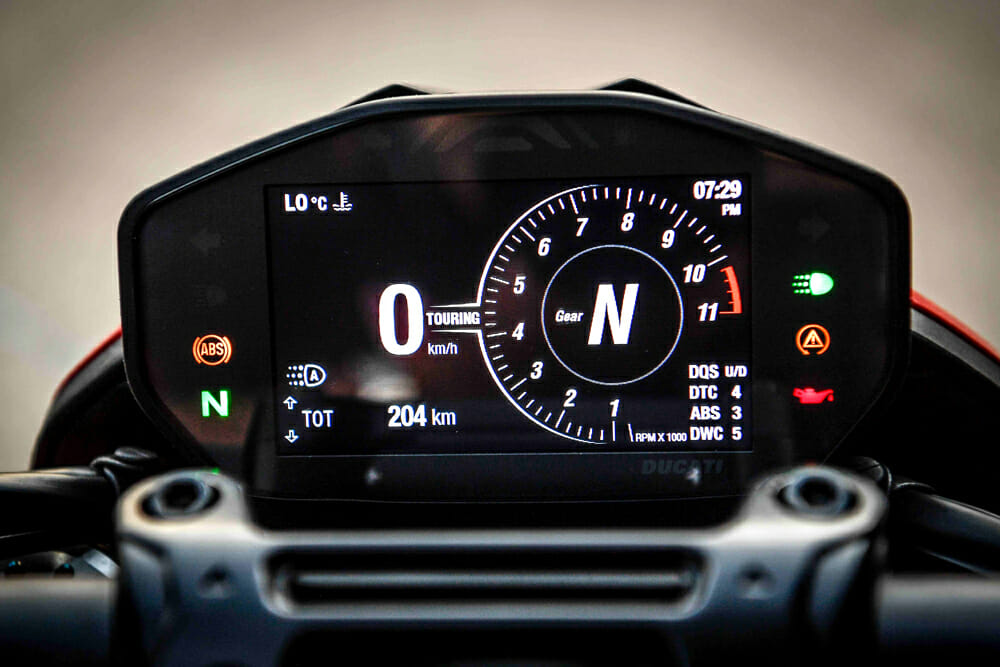 The 2019 Ducati Hypermotard 950 dash is reminiscent of the Panigale V4S unit but without quite the level of sophistication.
The 2019 Ducati Hypermotard 950 dash is reminiscent of the Panigale V4S unit but without quite the level of sophistication.
2019 Ducati Hypermotard 950 Review Conclusion
Overall the Hypermotard 950 is a fun, energetic, and satisfying machine. It’ll hoist a long wheelie on a mountain road or trot around town as politely as you like. Little touches of class go a long way, too. The clutch lever matches the front brake in that it’s a radial-pull, hydraulic setup that’s adjustable. Along with stupendous brakes and high-quality suspension, the switchgear is well built and the general fit and finish is admirable.
The most obvious question is: For the $13,295 that a standard Hyper 950 will cost, is it the bike you want? From Japan you can get a few different naked bikes with more power, but if you like the cut of a Hyper’s jib then you’re probably more interested in something European. From Aprilia you can get the supermoto-ish Dorsoduro 900 for a couple thousand dollars less, with a color dash and ABS. And from Triumph a Street (or even Speed) Triple, with equally good Brembo brakes and state-of-the-art amenities. Or, maybe most compelling, a KTM 790 Duke—a similarly rowdy engine, a color dash and sharp brakes, not to mention the ability to shut off rear ABS.
The competition is strong, and it brings to light the Hyper’s best trait: being itself. It may be too modern for supermoto purists, but it’s been a decade of creating a mystique and a style that no other bike can match. CN
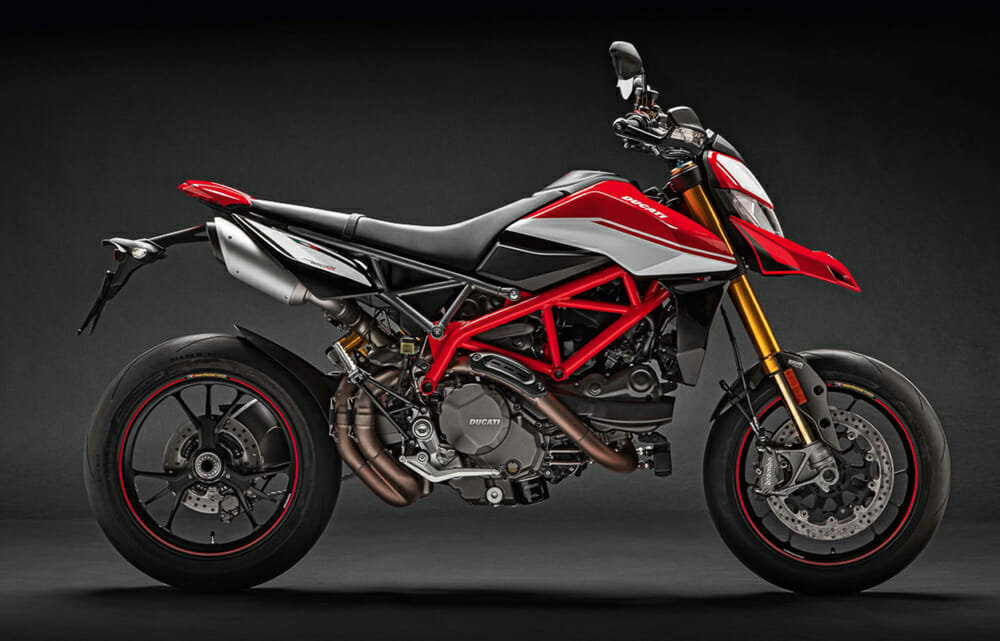
2019 Ducati Hypermotard 950 Specs
| MSRP: |
$13,295 base / SP $16,695 |
| Engine: |
Liquid-cooled, DOHC, 4-stroke, 90-deg. V-twin |
| Displacement: |
937cc |
| Bore x stroke: |
94 x 67.5mm |
| Compression ratio: |
13.3:1 |
| Clutch: |
Wet multi-plate |
| Transmission: |
6-speed |
| Chassis: |
Steel-tube Trellis |
| Front suspension: |
45mm Marzocchi inverted fork, fully adjustable (SP: 48mm Ӧhlins, fully adjustable) |
| Rear suspension: |
Sachs Monoshock, preload and rebound adjustable (SP: Ӧhlins, fully adjustable) |
| Front wheel travel: |
6.7 in. (SP: 7.3 in.) |
| Rear wheel travel: |
6.0 in. (SP: 7.0 in.) |
| Front brake: |
2 x 320mm disc, 4-piston calipers, Cornering ABS |
| Rear brake: |
245mm disc, 2-piston caliper, Cornering ABS |
| Front tire: |
120/70 17 in. Pirelli Diablo Rosso III (SP: Pirelli Supercorsa SP) |
| Rear tire: |
180/55 R17 in. Pirelli Diablo Rosso III (SP: Pirelli Supercorsa SP) |
| Wheelbase: |
58.8 in. (SP: 59 in.) |
| Seat height: |
34.2 in. (SP: 35 in.) |
| Fuel capacity: |
3.8 gal. |
| Weight (wet, claimed): |
440 lbs. (SP: 436 lbs.) |
| Colors: |
Red (SP: Red/White) |